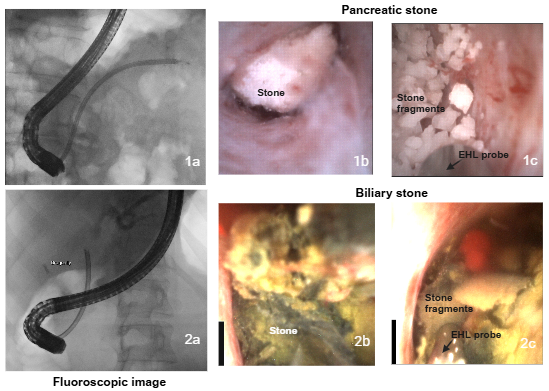Tuesday Poster Session
Category: Interventional Endoscopy
P5759 - Novel Single-Use Cholangiopancreatoscope-Guided Electrohydraulic Lithotripsy for Pancreatic and Biliary Stone Management: A Case Series
Tuesday, October 28, 2025
10:30 AM - 4:00 PM PDT
Location: Exhibit Hall

Chinmay Guralwar, MBBS (he/him/his)
Mayo Clinic
Rochester, MN
Presenting Author(s)
Chinmay Guralwar, MBBS, Shuji Mitsuhashi, MBBS, Elizabeth A. Lemke, MPH, Vinay Chandrasekhara, MD, Samuel Han, MD
Mayo Clinic, Rochester, MN
Introduction: Peroral cholangiopancreatoscopy (POCP) has advanced the management of complex biliary and pancreatic duct stones. However, traditional POCP platforms are limited by a 1.2 mm working channel, restricting the use of larger electrohydraulic lithotripsy (EHL) probes and contributing to premature probe failure, especially with large or resistant stones. The novel POCP (Dragonfly™) system offers a larger 1.7mm working channel, accommodating 4.5 Fr EHL probes, which are 2.4 times larger than the current standard 1.9 Fr probes. This may improve probe durability and lithotripsy efficiency. This case series describes our initial experience using the novel POCP system for management of complex pancreatic and biliary stones.
Case Description/
Methods: Three patients underwent POCP-guided EHL using the Dragonfly™ system. The procedures were performed by two experienced endoscopists. A 46-year-old male and an 86-year-old male with chronic calcific pancreatitis and pancreatic duct stones, underwent EHL with successful fragmentation and duct clearance using balloon and basket sweeps, followed by pancreatic duct stent placement. The procedure duration was 128 and 89 minutes, respectively. A third patient, a 24-year-old female with a malignant Bismuth type IV stricture and concurrent choledocholithiasis, underwent successful EHL of common bile duct stones, with complete stone clearance achieved with balloon extraction, followed by plastic stent placement during a 79-minute procedure.
Technical success with complete stone fragmentation was achieved in a single session for all cases. There were no periprocedural adverse events, and all patients were discharged home after the procedure. Post-procedure, the performing endoscopists completed a device performance evaluation using a Likert scale of 1-5 (5 representing the highest score). In all cases, the 4.5 Fr EHL probe passed smoothly through the novel POCP (median Likert score=5), and the system provided excellent visualization (median Likert score=5) and maneuverability (median Likert score=5).
Discussion: This novel POCP system demonstrated feasibility and safety in treating both pancreatic and bile duct stones with EHL. The larger working channel accommodated higher-capacity probes without technical difficulty and facilitated single-session stone clearance.

Figure: Figure 1. Dragonfly™ cholangiopancreatoscopy-guided electrohydraulic lithotripsy in the pancreatic and biliary ducts. 1a) Fluoroscopic image of pancreatoscope in the tail of the pancreatic duct; 1b) direct visualization of pancreatic duct stone; 1c) post-lithotripsy appearance of pancreatic duct stone fragments. 2a) Fluoroscopic image of cholangioscope in the biliary duct; 2b) cholangioscopy-guided visualization of biliary stones; 2c) post-lithotripsy appearance of biliary stone fragments.
Disclosures:
Chinmay Guralwar indicated no relevant financial relationships.
Shuji Mitsuhashi indicated no relevant financial relationships.
Elizabeth Lemke indicated no relevant financial relationships.
Vinay Chandrasekhara indicated no relevant financial relationships.
Samuel Han: Boston Scientific – Consultant.
Chinmay Guralwar, MBBS, Shuji Mitsuhashi, MBBS, Elizabeth A. Lemke, MPH, Vinay Chandrasekhara, MD, Samuel Han, MD. P5759 - Novel Single-Use Cholangiopancreatoscope-Guided Electrohydraulic Lithotripsy for Pancreatic and Biliary Stone Management: A Case Series, ACG 2025 Annual Scientific Meeting Abstracts. Phoenix, AZ: American College of Gastroenterology.
Mayo Clinic, Rochester, MN
Introduction: Peroral cholangiopancreatoscopy (POCP) has advanced the management of complex biliary and pancreatic duct stones. However, traditional POCP platforms are limited by a 1.2 mm working channel, restricting the use of larger electrohydraulic lithotripsy (EHL) probes and contributing to premature probe failure, especially with large or resistant stones. The novel POCP (Dragonfly™) system offers a larger 1.7mm working channel, accommodating 4.5 Fr EHL probes, which are 2.4 times larger than the current standard 1.9 Fr probes. This may improve probe durability and lithotripsy efficiency. This case series describes our initial experience using the novel POCP system for management of complex pancreatic and biliary stones.
Case Description/
Methods: Three patients underwent POCP-guided EHL using the Dragonfly™ system. The procedures were performed by two experienced endoscopists. A 46-year-old male and an 86-year-old male with chronic calcific pancreatitis and pancreatic duct stones, underwent EHL with successful fragmentation and duct clearance using balloon and basket sweeps, followed by pancreatic duct stent placement. The procedure duration was 128 and 89 minutes, respectively. A third patient, a 24-year-old female with a malignant Bismuth type IV stricture and concurrent choledocholithiasis, underwent successful EHL of common bile duct stones, with complete stone clearance achieved with balloon extraction, followed by plastic stent placement during a 79-minute procedure.
Technical success with complete stone fragmentation was achieved in a single session for all cases. There were no periprocedural adverse events, and all patients were discharged home after the procedure. Post-procedure, the performing endoscopists completed a device performance evaluation using a Likert scale of 1-5 (5 representing the highest score). In all cases, the 4.5 Fr EHL probe passed smoothly through the novel POCP (median Likert score=5), and the system provided excellent visualization (median Likert score=5) and maneuverability (median Likert score=5).
Discussion: This novel POCP system demonstrated feasibility and safety in treating both pancreatic and bile duct stones with EHL. The larger working channel accommodated higher-capacity probes without technical difficulty and facilitated single-session stone clearance.

Figure: Figure 1. Dragonfly™ cholangiopancreatoscopy-guided electrohydraulic lithotripsy in the pancreatic and biliary ducts. 1a) Fluoroscopic image of pancreatoscope in the tail of the pancreatic duct; 1b) direct visualization of pancreatic duct stone; 1c) post-lithotripsy appearance of pancreatic duct stone fragments. 2a) Fluoroscopic image of cholangioscope in the biliary duct; 2b) cholangioscopy-guided visualization of biliary stones; 2c) post-lithotripsy appearance of biliary stone fragments.
Disclosures:
Chinmay Guralwar indicated no relevant financial relationships.
Shuji Mitsuhashi indicated no relevant financial relationships.
Elizabeth Lemke indicated no relevant financial relationships.
Vinay Chandrasekhara indicated no relevant financial relationships.
Samuel Han: Boston Scientific – Consultant.
Chinmay Guralwar, MBBS, Shuji Mitsuhashi, MBBS, Elizabeth A. Lemke, MPH, Vinay Chandrasekhara, MD, Samuel Han, MD. P5759 - Novel Single-Use Cholangiopancreatoscope-Guided Electrohydraulic Lithotripsy for Pancreatic and Biliary Stone Management: A Case Series, ACG 2025 Annual Scientific Meeting Abstracts. Phoenix, AZ: American College of Gastroenterology.

